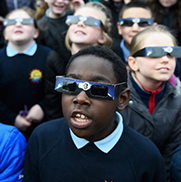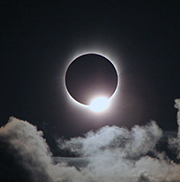COUNTDOWN TO TOTALITY* 22.07.28
Day(s)
:
Hour(s)
:
Minute(s)
:
Second(s)
Dangers of viewing the sun
Most people are aware that it is not safe to stare at the Sun.
Humans have an automatic response to look away or close their eyes when attempting to observe the Sun. This is a natural reaction that helps to protect our eyesight.
It is never safe to look directly at a partial solar eclipse or the partial phases of a total solar eclipse without the proper equipment and techniques.
When an eclipse is known to be occurring, children have a natural curiosity and may be tempted to try to look. They can be less aware than adults of the dangers of staring at the Sun.
This is exacerbated when there is a deep partial eclipse and the Sun is reduced to a thin crescent. In these cases the “look away” response may be reduced. We must reinfocre the message that viewing of the Sun without proper precautions at any time is dangerous. This is especially true for young children.
The primary concern over unprotected viewing of the Sun during an eclipse (or indeed at any other time) is the development of “eclipse blindness” or retinal burns.
Exposure of the retina to intense visible light causes damage to the eye’s light-sensitive rod and cone cells.
The light triggers a series of complex chemical reactions within the cells which damage their ability to function and, in extreme cases, can destroy them.
The result is a loss of vision, which may be either temporary or permanent, depending on the severity of the damage.
In addition, the high level of visible and near-infrared radiation can cause heating that literally cooks the exposed tissue. This thermal injury or photocoagulation destroys the rods and cones, creating a blind spot burned into the retina.
There are two effects which compound the danger. Firstly the injuries occur without any feeling of pain (the retina has no pain receptors) and secondly the visual effects may not become apparent for at least several hours after the damage is done. For these reasons, significant damage may occur without the victim being aware of it.
Because optical instruments intensify the light, looking at the Sun through an unfiltered telescope or binoculars is very dangerous as it can cause permanent damage almost immediately.
It is never safe to look directly at a partial or annular eclipse or the partial phases of a total solar eclipse without the proper equipment and techniques.
Even when 99% of the Sun’s surface (the photosphere) is obscured during the partial phases of a solar eclipse, the remaining crescent Sun is still intense enough to cause a retinal burn, even though illumination levels may be comparable to twilight.
Failure to use proper observing methods may result in permanent eye damage and severe visual loss.
Looking directly at the Sun is unsafe except during the brief total phase (“totality”) of a total solar eclipse, when the Moon entirely blocks the Sun’s bright face. This happens only within the narrow path of totality.
To find out whether your home or any other specific location is within the path of the 22 July 2028, Australian total solar eclipse, see Xavier Jubier’s Google Map, which supports zooming in to street level.
During a partial or annular (ring) solar eclipse, there is no time when it is safe to look directly at the Sun without using a special-purpose solar filter that complies with the transmission requirements of the ISO 12312-2 international standard.
The only safe way to look directly at the uneclipsed, partially eclipsed, or annularly eclipsed Sun is through special-purpose solar filters, such as “eclipse glasses” or handheld solar viewers (examples shown below).
Homemade filters or ordinary sunglasses, even very dark ones, are not safe for looking at the Sun; they transmit thousands of times too much sunlight.
See the Reputable Manufacturers of Solar Filters & Viewers page for a list of manufacturers of solar viewers verified to be compliant with the transmission requirements of the ISO 12312-2 international safety standard.
If possible check eclipse glasses or filters you are intending to buy, to see that the manufacturer is one of those on the list.
Examples Of Solar Viewers
Instructions for the Safe Use of Solar Filters/Viewers
1) Always inspect your solar filter before use; if scratched, punctured, torn, or otherwise damaged, discard it. Read and follow any instructions printed on or packaged with the filter.
2) Always supervise children using solar filters.
3) If you normally wear eyeglasses for distance viewing, keep them on. Put your eclipse glasses on over them, or hold your handheld viewer in front of them.
4) Stand still and cover your eyes with your eclipse glasses or solar viewer before looking up at the bright Sun. After looking at the Sun, turn away and remove your filter — do not remove it while looking at the Sun.
5) Seek expert advice from an astronomer before using a solar filter with a camera, telescope, binoculars, or any other optical device; note that solar filters must be attached to the front of any telescope, binoculars, camera lens, or other optics.
1) Do not look at the Sun through a camera, telescope, binoculars, or any other optical device while using your eclipse glasses or handheld solar viewer — the concentrated solar rays could damage the filter and enter your eye(s), causing serious injury.
2) Do not look at the uneclipsed, partially eclipsed, or annularly eclipsed Sun through an unfiltered camera, telescope, binoculars, or other optical device.
If you are inside the path of totality on 22 July 2028, remove your solar filter only when the Moon completely covers the Sun’s bright face and it suddenly gets quite dark.
Experience totality, then, as soon as the bright Sun begins to reappear, replace your solar viewer to look at the remaining partial phases. Note that this applies only to viewing without optical aid (other than ordinary eyeglasses).
Different rules apply when viewing or imaging the Sun through camera lenses, binoculars, or telescopes; consult an expert astronomer before using a solar filter with any type of magnifying optics.
If you are Outside the path of totality, and throughout a partial or annular solar eclipse, you must always use a safe solar filter to view the Sun directly.
Frequently Asked Questions
Do Eclipse Glasses & Handheld Viewers Expire?
If your eclipse glasses or viewers are compliant with the transmission requirements of the ISO 12312-2 safety standard, and if their filters aren’t scratched, punctured, torn, coming loose from the frame, or otherwise damaged, you may reuse them indefinitely.
Furthermore, you may look at the uneclipsed or partially eclipsed Sun through them for as long as you wish. Some glasses/viewers are printed with warnings stating that you shouldn’t look through them for more than 3 minutes at a time and that you should discard them if they are more than 3 years old.
Such warnings do not apply to eclipse viewers compliant with the ISO 12312-2 standard (assuming they are in excellent condition). To make sure you get (or got) your eclipse glasses/viewers from a supplier of ISO-compliant products,
see our Reputable Manufacturers of Solar Filters & Viewers page.
Is It Safe to Clean Eclipse Glasses and Handheld Solar Viewers?
Manufacturers of hard plastic eclipse glasses often supply a microfiber pouch that you may use to wipe the lenses clean.
The same pouch may be used on the lenses of cardboard eclipse glasses and handheld solar viewers.
You may also wipe them clean with any soft, nonabrasive tissue or cloth; Kimwipes are also suitable, but baby wipes and other wet wipes are not suitable.
Cardboard must be kept dry; if it gets wet, it will swell and likely detach from the lenses.
Do not use water, glass cleaner, or any other solvents or liquids to clean cardboard eclipse glasses and handheld solar viewers.
What If You Don’t Have a Safe Solar Filter/Viewer?
An alternative method for safe viewing of the partially eclipsed Sun is indirectly via pinhole projection.
For example, cross the outstretched, slightly open fingers of one hand over the outstretched, slightly open fingers of the other, creating a criss-cross pattern. With your back to the Sun, look at your hands’ shadow on the ground.
The little spaces between your fingers will project a grid of small images on the ground, showing the Sun as a crescent during the partial phases of any solar eclipse or as a ring during the annular phase of an annular eclipse.
Or just look at the shadow of a leafy tree during a partial or annular eclipse; you’ll see the ground dappled with crescent or ring-shaped Suns projected by the tiny spaces between the leaves.
A solar eclipse is one of nature’s grandest spectacles. By following these simple rules, you can safely enjoy the view and be rewarded with memories to last a lifetime.









